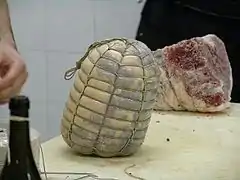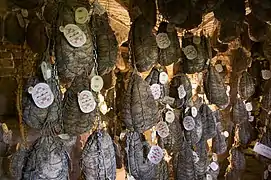 | |
| Region or state | Emilia-Romagna |
|---|---|
Culatello di Zibello is a cured meat with a protected designation of origin (PDO) in the EU and UK (EC regulation n° 1263/96) typical of the province of Parma. Listed among the Slow Food Presidia of Emilia-Romagna, culatello, mentioned for the first time in a document dating back to 1735, is produced from the leg of pork, which is then stuffed into the pig's bladder.
Production
The Consortium of Culatello di Zibello has established that the processing of culatello di Zibello can only take place in a specific and circumscribed area and exclusively in the period between October and February, when the Bassa is enveloped in fog and cold. It is in that period that the part of meat obtained from the thigh of adult pigs, bred according to traditional methods, is skinned, degreased, boned, separated from the fiocchetto and trimmed by hand, so as to give it its characteristic "pear" shape. The culatello and fiocchetto trimmings are then used in the preparation of strolghino.
These operations are followed, after about ten days, by salting and the so-called investiture, that is, the stuffing of the cured meat into the pig's bladder and the tying with string which, after aging, must have a large, irregular mesh. The aging in the cellar accompanies culatello from the winter fog to the summer heat, to arrive on tables the following winter in the fullness of its most original flavor qualities.
The aging period is from a minimum of 10 months for the smaller pieces (at least 3 kg) up to an average of 14 months for all pieces. The annual production is about 50,000 pieces of culatello di Zibello PDO.[1]
Gallery
 The meat stuffed inside of a bladder, before the aging process
The meat stuffed inside of a bladder, before the aging process.jpg.webp) Aged culatello
Aged culatello.jpg.webp) Detail of the Consortium label
Detail of the Consortium label Several culatelli in a shop
Several culatelli in a shop Culatello with burrata
Culatello with burrata Curing basement
Curing basement
References
- ↑ ""Culatello di Zibello" DOP, produzione e attività di controllo" (PDF). old.unipr.it.
See also
- Culatello con cotenna
- Prosciutto di Parma
- Coppa di Parma
- Salame Felino
- Spalla di San Secondo
- Strolghino
- Fiocchetto (salume)
- Parmesan cuisine
- Cuisine of Emilia-Romagna
External links
 Wikizionario contiene il lemma di dizionario «culatello»
Wikizionario contiene il lemma di dizionario «culatello» Wikimedia Commons contiene immagini o altri file sul culatello
Wikimedia Commons contiene immagini o altri file sul culatello